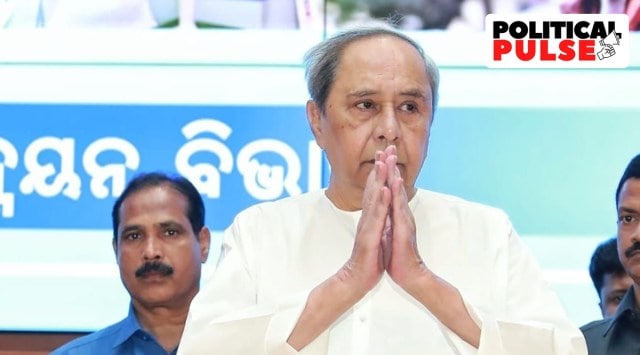AS THE Centre moves into the next leg of its National Food Security scheme, providing rice, wheat and coarse grains free to around 81 crore across the country, Odisha stands as a shining example of how food schemes – specifically to provide cheap rice – can be a winner.
And not just for the state, known for its poverty and alleged starvation deaths earlier, but also the ruling Biju Janata Dal, which has defied anti-incumbency to continue on and on in government.

It was in 2008 that Chief Minister Naveen Patnaik first unveiled the scheme to provide Rs 2 per kg rice to around 60 lakh families in the state.
Odisha was not the first, with a few southern states like Andhra Pradesh and Tamil Nadu already having versions of this programme.
In Odisha, the scheme, that came to be popularly known as “Di tankia chaula (Rs 2 per kg rice)”, was a major hit. It was believed to be one of the biggest factors behind Patnaik returning to power in 2009, when everyone expected setbacks from the BJD’s decision to sever ties with the BJP. The BJD bagged 103 of the 129 Assembly seats and 14 of the 20 Lok Sabha seats in the 2009 Assembly and Lok Sabha polls, respectively.
While the Opposition kept claiming that the scheme was an election sop, and would be wound up afterwards, the Patnaik government persisted and even revised the scheme to Re 1/kg in January 2013, this time just a year before the 2014 polls.
The BJD again retained power, beating back the Narendra Modi-led BJP juggernaut that year. The regional party didn’t just win 117 of the 147 seats but swept the Lok Sabha polls with 20 of the 21 seats.
Story continues below this ad
“Since rice or wheat is a basic need, it’s an easy plank to get connected with people emotionally, and CM Naveen Patnaik realised it early. Even as the Centre was bearing a lion’s share in the subsidised rice scheme, the BJD took the mileage by repackaging it in Odisha over the years,” says a retired bureaucrat, requesting anonymity.
In 2014, when the centrally-sponsored National Food Security Act (NFSA) was implemented in Odisha, the CM said that it left out around 25 lakh eligible poor because of the limit fixed by the Centre for the state. Hence, in October 2018, again timed to a couple of months before the 2019 polls, the BJD government announced its own State Food Security Scheme (SFSS), providing Rs 5 kg rice per individual at Re 1, at par with the NFSA.
Though the government’s target was over 25 lakh individuals under the SFSS, only nine lakh individuals are actually covered under it.
Patnaik talks repeatedly of not letting a single person go hungry in Odisha, while lauding the state’s rice scheme. In June last year, talking of “Odisha’s success story” at a World Food Programme meeting in Rome, he talked of Odisha’s “transformational journey” in the field of food production, food security and livelihoods over the past two decades.
According to a report released by the International Food Policy Research Institute (IFPRI) along with the Azim Premji Philanthropic Initiative in December 2020, Odisha has made more rapid progress in reducing child undernutrition than several richer states. Particularly between 2006 and 2016, nutrition and health outcomes improved significantly in the state. The prevalence of stunting declined from 45 per cent to 34.1 per cent, although there was a marginal increase in wasting. In 2018, a further decline was noted in the prevalence of stunting to 28.9 per cent.
Story continues below this ad
The report also stated that though anemia among women of reproductive age declined by 10 per cent between 2006 and 2016, it’s still high, with over half the women in Odisha suffering from anemia. According to data with the state health department, anemia is a public health concern in Odisha, affecting 30 to 65% people across different vulnerable groups.
With the Centre now announcing free foodgrains to those eligible under the NFSA, as it winds up its PMGKAY (PM Garib Kalyan Anna Yojana) programme timed with Covid, the Odisha CM was again quick on the uptake. He said his government will provide free rice to around 9 lakh beneficiaries now enrolled under the SFSS, and that the expenditure of Rs 185 crore would be met by the state exchequer.
Opposition parties such as the BJP and Congress, which have been stressing for long that the Centre bears the lions’ share in allocation of subsidised rice and that the Patnaik government’s role is minimal, is repeating the same again.
Senior BJP leader Pravati Parida said the BJD feared erosion of its support base following the Centre’s move. “They may have feared they would get exposed after the Centre’s decision to provide rice free to NFSA beneficiaries, and so announced the same under the SFSS,” Parida said.
State Food Supplies and Consumer Welfare Minister Atanu Sabyasachi Nayak said the BJD government has never done anything to gain political mileage. “Our government does not believe in competing with others while rolling out welfare schemes. Our only objective is to ensure peoples’ benefit,” said Nayak.
Story continues below this ad
Union Minister Dharmendra Pradhan, who belongs to Odisha, said the state should distribute the rice provided by the Centre for NFSA beneficiaries “in a rightful manner”. He also claimed that 3.25 crore of Odisha’s 4.5 crore population was getting benefits under the NFSA, with the Modi government providing 1.87 lakh MT rice to the state at a cost of around Rs 8,400 crore per year.
Odisha government officials in turn mocked that given Pradhan’s claims, Odisha could save around Rs 1,100 crore annually as its share to the NFSA. With that amount, officials said, they could even come up with a new scheme.

































